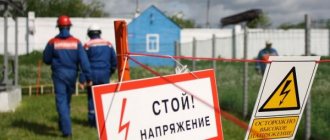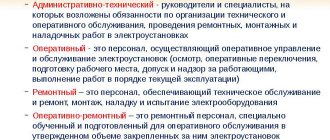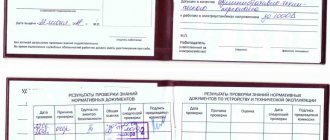In a comprehensive system of ensuring safety when carrying out work at any facility (enterprise or organization), labor protection takes an honorable leading place. Without the consent of a TB specialist, no work operation is carried out on them in which there are elements of a threat to human health or a danger of injury.
PTEEP
According to safety requirements, any employee of the enterprise, before starting such work, must obtain a special permit, which is an official confirmation of his readiness for it. So, in order to obtain the 3rd group in electrical safety (which gives the right to carry out work with electrical equipment), you will need to pass a special commission that evaluates the level of training of the applicant.
Therefore, when preparing for the exam, you will need to familiarize yourself with a large list of questions on electrical safety contained in the exam cards, as well as study the current regulatory documentation and a number of additional manuals (a photo of one of them is given below).
Immediately before certification, it is also advisable for the future owner of the third group of admission to review the characteristic errors that arise in the answers to questions asked during certification. Moreover, their total number, according to various sources, may exceed one hundred, which will require the applicant for the third group to make certain efforts.
Features of preparation for certification
In order for the preparation for the exam to be successful, just studying all the regulatory documentation (including PUE, PTEEP and others) will not be enough. The fact is that during the certification, very specific questions are asked regarding various work situations, the answers to which are usually not given in ordinary sources.
They consider only general requirements and standards relating to the operation of electrical installations with voltages above 1000 Volts. Therefore, you will have to give answers on electrical safety according to the same principle (that is, taking into account specific situations and conditions, as well as broken down by topic).
And this is only possible if the examinee was able to get somewhere and carefully analyze tickets with answers on electrical safety, group 3, developed under the patronage of Rostechnadzor. As a rule, such tickets “travel from hand to hand” and are quite accessible to anyone who would like to get acquainted with correctly formulated answers.
In addition, there are specially developed systems such as Olympus OKS (they are considered and called alternative) for persons taking all known groups from the second to the fifth. To use them, you will need to try a little and surf the Internet.
Additional Information. The Olympus OC system is designed both for individual acquisition of knowledge and for classes in groups of thirty people or more.
Good support for all those who need a preliminary study of the questions themselves and the answers to them is provided by a website specially created for this purpose called tests24. Anyone applying for the third group can access this very useful resource if they type tests24.ru in the address bar and go to the desired address.
Another assistant in preparing for the certification is a resource called “testsmart”. It is here that all the most important questions are grouped strictly by topic, which will greatly facilitate the preparation for passing the certification.
Examples of general questions
Tickets with answers on electrical safety
Among the variety of test tasks, which can include one hundred questions, the main attention is paid to the general provisions of the current regulatory documentation. In order to obtain the 3rd group of electrical safety clearance, first of all, you will need to carefully check all the proposed questions with the provisions of the PUE (taking into account the latest changes and additions).
The section called “general” includes the following typical examples (questions and answers are given in turn below):
- Which of the electrical devices operating at the enterprise can be classified as operating electrical equipment (including systems designed for voltages above 1000 Volts);
- How are neutral conductors correctly indicated on diagrams and on the housings of station units (they are in the middle in the photo below);
Neutral conductor
- How is the grounding wire required to protect service personnel from electric shock marked?
- How is the so-called “combined” conductor, which includes a protective and working busbar, correctly designated?
- How, according to TB requirements, are tires intended for supplying three-phase voltage to the consumer distinguished (by color and letter marking);
- How are the busbars used in DC power lines different and designated?
The answer to the first general question looks like this: the category of operating electrical installations includes equipment that is currently fully or partially energized. It must be equipped with switching devices through which it is supplied with a power supply of 220 or 380 Volts.
The correct answer to the second of these questions will be this: the neutral conductor differs from other connecting conductors in the blue color of the protective insulation, and in diagrams (and sometimes in reality) it is designated by the English letter N.
Also, the person taking the exam should know that protective busbars, in order to distinguish them from other conductors, are laid in insulation with alternating green and yellow stripes of the same width applied along the entire length. To designate them, allowing the color difference to be duplicated, a double PE icon is used (in the photo it is the bottom one).
Protective conductor PE
Note! The designation PEN usually refers to a combined protective conductor that simultaneously performs a working and protective function.
When answering the fifth of the questions included in the tests, you should note the following points:
- Power buses laid to provide the user with a three-phase voltage of 380 Volts are marked in different colors at the station;
- The first, usually called tire “A”, is painted yellow, and the second “B” is painted green;
- The last third tire is marked in red and designated with the letter “C”.
Buses that pass direct current through them must also have different colors (see photo below).
Designation of DC buses
The first (1), having the schematic designation “+”, is usually marked in red. The second of these conductors is negative and is marked with a “-” icon (its standard color is blue).
And finally, an applicant taking the exam for the 3rd admission group should know that the third of the wires, related to the zero buses, is designated by the letter “M” and is placed in blue protective insulation.
EB 302.2. III group for electrical safety up to 1000 V
EB 302.2. Tests for group 3. All materials presented in this electrical safety section are compiled according to the Olimpox , which is used during certification for the electrical safety clearance group in Rostechnadzor . Educational materials and information are not an official source and are used for self-study for the electrical safety clearance group.
Topic 1. General information about electrical installations 40 questions
Basic information about electrical installations and electrical equipment. Terms and Definitions.
General requirements of safety rules for the operation of consumer electrical installations.
Responsibility and supervision of compliance with norms and rules of work in electrical installations
•Rules for technical operation of consumer electrical installations (PTEEP)
•Order of the Ministry of Labor of Russia dated July 24, 2013 N 328n “On approval of the Rules for labor protection during the operation of electrical installations”
•Rules for electrical installations (PUE)
Topic 2. Requirements for personnel and their training 21 questions
Personnel tasks. Characteristics of administrative and technical, operational, maintenance, operational and repair electrical personnel. Characteristics of electrical engineering personnel.
Personnel training. Electrical safety groups and conditions for their assignment
•Rules for technical operation of consumer electrical installations (PTEEP)
•Order of the Ministry of Labor of Russia dated July 24, 2013 N 328n “On approval of the Rules for labor protection during the operation of electrical installations”
Topic 3. Procedure and conditions for safe work in electrical installations 42 questions
Organizational measures to ensure work safety. Responsible for work safety. Brigade composition. Technical measures to ensure the safety of work with stress relief. Safety measures when performing certain works
•Rules for technical operation of consumer electrical installations (PTEEP)
•Order of the Ministry of Labor of Russia dated July 24, 2013 N 328n “On approval of the Rules for labor protection during the operation of electrical installations”
Topic 4. Grounding and protective measures for electrical safety. Lightning protection 25 questions
Methods for performing grounding. Insulation of electrical installations. Basic measures to ensure electrical safety. Lightning protection.
•Rules for technical operation of consumer electrical installations (PTEEP)
•Rules for electrical installations (extraction) (PUE)
•Instructions for the installation of lightning protection of buildings, structures and industrial communications (SO 153-34.21.122-2003)
Topic 5. Rules for the use and testing of protective equipment used in electrical installations 21 questions
Requirements for protective equipment used in electrical installations.
Rules for using protective equipment
•Instructions for the use and testing of protective equipment used in electrical installations (SO 153-34.03.603-2003)
Topic 6. Rules for releasing victims from electric current and providing them with first aid 13 questions
General rules for first aid. The effect of electric current on the human body. The procedure for freeing the victim from live parts that are energized. Rules for providing first aid to victims of electric shock
•Instructions for first aid in case of accidents at work (approved by RAO UES of Russia)
Electrical receivers
Electrical Safety Group 4
In addition to a good knowledge of the rules for marking and designating elements of electrical mains, a person being tested for electrical safety must also have an understanding of electricity receivers.
Explanation. Such receivers mean a variety of devices designed to convert electricity from one type to another (see photo below).
Electrical receivers
In addition to understanding the principles of operation of these units, the third tolerance group, assigned based on the results of the test subject’s certification, presupposes knowledge of which category the electrical equipment operating at a given facility belongs to.
So, one of the questions characteristic of this section is: what types of electricity receivers are classified in the 2nd group in terms of reliability?
When answering this question, you should know that electrical installations belonging to this group are considered to be units and structures, the emergency shutdown of which can lead to significant losses at a given enterprise.
During the knowledge test, the test taker must explain to the examiner that in general all types of electrical installations equated to socially significant objects must have this category.
A complete and objective testing of the applicant may include the following question: which of the electricity receivers are usually assigned category 3 in terms of their reliability?
This group should include installations operating with voltages up to and above 1000 Volts, a forced interruption in the energy supply of which can lead to irreparable material losses. Thus, any production facilities, the interruption of current supply to which may pose a threat to the safety and health of people, should be equated to the third group.
Of the variety of exam tasks (remember that their number can exceed one hundred), a special place is occupied by questions related to regulatory and technical documentation regulating the procedure for carrying out work in electrical installations.
Answers to such tasks must list all regulations and documents used in daily work that are directly related to electricity. The list of basic standards must include PUE, PTEEP, MPBEE, as well as SNiPs and GOSTs relating to tools and individual parts used during work operations.
In conclusion, we note that modern technical training systems (simply one hundred) can include a wide variety of topics and questions used in the preparation of test tasks for certification for the safety group when working with electrical equipment. Accurate knowledge of all the answers, the number of which can sometimes exceed one hundred, will allow the examinee to receive a certificate in a timely manner, as well as significantly increase the guarantee of safety at work.
EXAMINATION TICKETS for certification of electricians for servicing substations (III and IV categories)
EXAMINATION TICKETS for certification of electricians for servicing substations (III and IV categories)
B I L E T No. 1.
- Electric charge and electric field. Coulomb's law. Tension and potential, electric field work.
- Metals and alloys used in energy. Corrosion of metal.
- Enclosed distribution devices. Advantages and disadvantages.
- Requirements for personnel servicing electrical installations. Briefings upon hiring.
- Safety when working with power tools.
B I L E T No. 2.
- Electricity. Current source, its electromotive force. Electrical circuit.
- Insulating electrical materials: gaseous, liquid, solid. Their characteristics.
- Complete distribution devices for indoor and outdoor installation.
- The effect of electric current on the human body. Dangerous and harmful factors affecting humans in operating electrical installations.
- The work producer has his responsibilities and combinations.
B I L E T No. 3.
- Resistance and conductivity of a conductor to electric current. Units.
- Heating of conductors and devices by current during normal operation and under abnormal conditions. Thermal resistance of conductors and devices.
- Acceptance and handover of shifts by operational personnel on duty.
- Possible cases of electric shock to a person.
- Responsibilities of the issuer of the permit, order.
B I L E T No. 4.
- Electric current strength and density. Ohm's law for a section of a chain and for a complete chain.
- Power transformers and autotransformers. Their device.
- Relay protection of electrical equipment, its purpose.
Basic requirements for relay protection.
- Freeing the victim from electric current in installations
up to 1000 V.
- The permitter, his responsibilities in preparing the workplace and allowing the team to work.
B I L E T No. 5.
- Serial and parallel connection of conductors. Complex electrical circuit. Kirchhoff's laws.
- Characteristics of a three-phase power transformer. Winding connection diagrams. Groups of connections. Conditions for parallel operation of transformers.
- Electromechanical devices, principles of their operation, accuracy classes.
- Freeing the victim from electric current in installations
above 1000 V.
- Accounting and storage of protective equipment. Frequency of inspections and tests.
B I L E T No. 6.
- Work and power of electric current. Joule-Lenz law. Application of the thermal effect of current.
- Voltage transformer. Purpose, circuit diagram for connecting the NTMI-10 transformer to the circuit.
- Blocking at a substation, its purpose. Blocking from erroneous actions with disconnectors.
- Safety of work using ladders, scaffolding, scaffolding.
- Responsible manager of work at the substation, his responsibilities and combinations.
B I L E T No. 7.
- Chemical effect of current. Galvanic couple, galvanic element. Batteries. Connecting sources to batteries.
- Oil switches, their types, main characteristics.
- The procedure for removing electrical equipment from service for repair and from repair to reserve.
- Carrying out artificial respiration and chest compressions.
- Classification of premises according to electrical safety.
B I L E T No. 8.
- Dielectric, its polarization in an electric field. The dielectric constant. Flat capacitor. Capacitor banks.
- Disconnectors, separators, short circuiters, load switches. Purpose, device, work.
- Operating principle and design of air switches. Possible malfunctions.
- Basic and additional personal protective equipment in installations up to 1000 V.
- Classification of premises according to fire and explosion safety. Storage of flammable and explosive materials.
B I L E T No. 9.
- Magnetic field of electric current. Tension, magnetic induction and magnetic flux of a magnetic field, their units of measurement.
- Current transformers: purpose, device, circuit diagram. Safety of work with current transformers.
- Vacuum switches, their operating principle and design. Possible malfunctions in the drive.
- Basic and additional personal protective equipment in installations above 1000 V.
- Fire prevention measures at the substation.
B I L E T No. 10.
- Magnetic permeability of a substance. Ferromagnets. Magnetic hysteresis. Application of magnetic materials.
- Concrete and oil reactors, arc suppression coils - purpose, design, operation.
- Purpose, principle of operation and operation of electromagnetic interlocks on a substation.
- Minimum permissible distances from people and machine mechanisms to live parts of an electrical installation that are energized.
- Rules for the use of open flame during repair work at a substation.
B I L E T No. 11.
- The magnitude and direction of the force acting on a current-carrying conductor in a magnetic field. Application of the phenomenon.
- Batteries and chargers at the substation, their maintenance.
- Faults and damage to power transformers. Preventive measurements and tests of transformers.
- Work performed at the substation by order and in the course of routine operation.
- Fire extinguishing equipment at the substation. Rules for using fire extinguishers.
B I L E T No. 12.
- The phenomenon of electromagnetic induction. The magnitude and direction of the emf. induction. Application of the phenomenon.
- Operating current at the substation. Secondary control, alarm and protection circuits. Control of their isolation.
- Damage to disconnectors, separators, short circuits, load switches.
- Responsibilities of the supervisor and team members.
- Safety rules when working with lifting mechanisms and devices (winches, hoists, jacks, ropes, etc.)
B I L E T No. 13.
- Self-induction. Conductor inductance. Magnetic field of a solenoid with current. Magnetic field energy.
- Working grounding. Design of the grounding device. Lightning protection at a substation.
- Connection and termination of wires and cables. Electrical contact, its resistance.
- Safety of work with workshop equipment and metalwork tools.
- First aid for chemical burns and gas poisoning.
B I L E T No. 14.
- Alternating current, its receipt. AC parameters. Linear and phase voltages of three-phase alternating current.
- Valve arresters, surge suppressors: design, operation. Their service.
- Damage to electrical equipment from erroneous actions of operating personnel, due to failure of protection or their false operation.
- Organizational measures to ensure electrical safety when working in electrical installations.
- Priority actions of personnel upon detection of a fire. His participation in putting out the fire.
B I L E T No. 15.
- Conductor resistance to alternating current: active, capacitive, inductive, total.
- Wires, their types and brands. Methods of laying wires indoors. Classification of premises.
- Types of equipment repairs. Organization of repairs. Unscheduled repairs.
- Technical measures to ensure electrical safety when working in electrical installations.
- Dielectric gloves, indicators and voltage indicators. Norms and terms of their testing.
B I L E T No. 16.
- Series and parallel connection of inductance and capacitance in an alternating current circuit. Phenomena of voltage and current resonances. Application of these phenomena.
- Transformer oil, its properties. Substation oil facilities. Transportation, storage, regeneration of transformer oil. Sampling for analysis.
- Cables, their brands. Laying methods.
- Persons responsible for safe work in electrical installations.
- Portable grounding. Purpose, device, application.
B I L E T No. 17.
- Three-phase alternating current generator. Connections of generator windings and power receivers in star and delta.
- Permissible heating temperatures of live parts of electrical equipment. Devices for monitoring the temperature of contact connections.
- Operating condition of electrical equipment. The sequence of operations with communication devices when removing equipment for repair.
- Step voltage, protection against it at the substation.
- Lighting at the substation. Service security. Requirements for portable lighting.
B I L E T No. 18.
- The principle of operation of the transformer. Its main characteristics. Types of cooling of transformers, their designation.
- Compressor facilities of the substation. Receiver.
- Operations and operational management personnel on shift. General rules for the production of operational switching.
- Protective grounding and grounding. Touch tension. Residual current devices (RCDs). Isolation transformers.
- First aid for thermal burns and frostbite.
B I L E T No. 19.
- Rotating magnetic field of a three-phase alternating current system. The operating principle of an asynchronous motor.
- Classification of distribution devices. Basic requirements of PUE and PTE for them.
- Contents of electrical equipment maintenance. Inspections, preventive tests, equipment repairs; their frequency.
- The procedure for applying portable grounding.
- Types of bleeding. First aid for bleeding.
B I L E T No. 20.
- AC power. Power factor. Three-phase current power.
- Open switchgears, basic equipment. Advantages and disadvantages of outdoor switchgear.
- Monitoring the insulation condition of electrical equipment. Insulation resistance measurement and testing.
- Safety when working with electrical clamps and rods, megohmmeter.
5. First aid for fractures, bruises, dislocations










